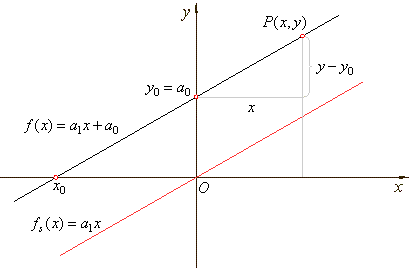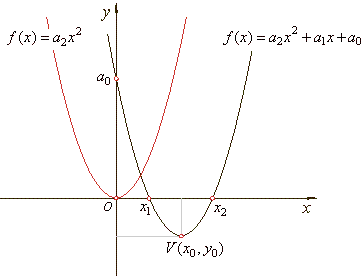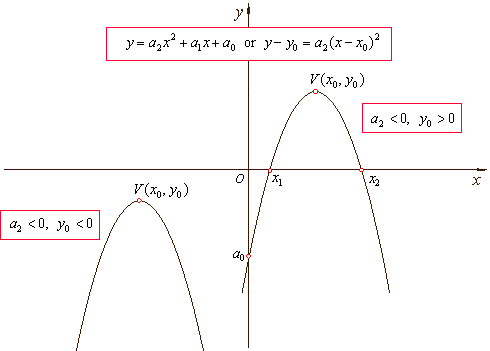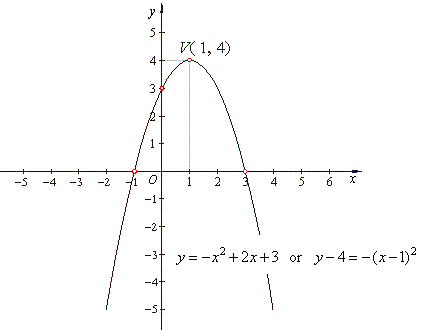|
|
|
|
Polynomial and/or Polynomial
Functions and Equations |
 Zeros of
a polynomial function
Zeros of
a polynomial function |
 Graphing
polynomial functions
Graphing
polynomial functions |
|
Zero polynomial |
|
Constant function |
|
Linear function |
|
Quadratic function |
|
Transformations
of the graph of the quadratic function |
|
|
|
|
|
|
| Zeros
of a polynomial function |
| The
zeros of a polynomial function are the values of x
for which the function equals zero. |
| That
is, the solutions of the equation f
(x)
= 0,
that are called roots of the polynomial, are the zeros of the
polynomial function or the x-intercepts of its
graph in a coordinate plane. |
| At
these points the graph of the polynomial function cuts or
touches the x-axis. |
| If
the graph of a polynomial intersects with the x-axis
at (a,
0), or x
= a
is a root or zero of a polynomial, then
(x
-
a)
is a factor of that polynomial. |
| Every
polynomial of degree n
has exactly n
real or complex zeros. |
| An
nth
degree polynomial has at most n
real zeros. |
| Some
of the roots may be repeated. The number of times a root is
repeated is called multiplicity or
order of the root. |
| The
number
xi
is a root of the
polynomial f
(x)
if and only if
f (x)
is divisible by
(x
-
xi).
|
| Thus, finding the
roots of a
polynomial f
(x)
s equivalent to finding its
linear divisors or is equivalent to polynomial
factorization into
linear factors. |
|
| Graphing
polynomial functions |
| Polynomial
functions are named in accordance to their degree. |
|
| Zero polynomial |
| The
constant polynomial f
(x)
= 0
is called the zero polynomial and
is graphically represented by the x-axis. |
|
| Constant function |
| A
polynomial of degree 0, f
(x)
= a0,
is called a constant function,
its
graph is a horizontal line with y-intercept
a0. |
 |
|
| Linear function |
| The
polynomial function of the first degree, f
(x)
= a1x
+ a0, is called a linear function. |
 |
| Since
y
= f (x)
then
|
y
= a1x
+ a0
or y
= a1(x
-
x0)
or y
-
y0
= a1x, |
|
|
| where |
 |
is the slope
of the linear function, |
|
| and
where |
 |
are the coordinates
of translations of the linear function. |
|
|
| by
setting x0
=
y0
= 0,
follows |
y
= a1x,
the source linear function. |
|
|
|
| Quadratic function |
| The
polynomial function of the second degree, f
(x)
=
a2x2
+ a1x
+ a0, is called a
quadratic function. |
 |
| |
y
= f(x)
=
a2x2
+ a1x
+ a0
or y
-
y0
= a2(x
-
x0)2, |
where |
|
|
 |
coordinates
of translations of the quadratic function. |
|
| by
setting x0
=
y0
= 0,
follows |
y
=
a2x2,
the source quadratic function.
The turning point V(x0,
y0). |
|
| The
real zeros of the
quadratic function: |
 |
|
|
| |
y
= f(x) =
a2x2
+ a1x
+ a0 = a2(x
- x1)(x
- x2)
= a2[x2
-
(x1 +
x2)x
+
x1x2] |
|
|
| The graph of a quadratic function is curve called a parabola. |
| The parabola is symmetric with respect to a vertical line
called the axis of symmetry. |
| As
the axis of symmetry passes through the vertex of the parabola
its equation is x
= x0. |
|
| Transformations
of the graph of the quadratic function |
| How
changes in the expression of the quadratic function affect its
graph is shown in the figures below. |
|
|
|
|
 |
|
|
The graph of quadratic polynomial will intersect the
x-axis in two
distinct points if its leading coefficient
a2 and the vertical translation
y0
have different signs, i.e., if a2
· y0
<
0. |
|
|
| Example:
Find zeros and vertex of
the quadratic function y
=
-
x2
+ 2x
+
3
and sketch its graph. |
| Solution:
A quadratic function can
be rewritten into translatable form y
-
y0
= a2(x
-
x0)2
by completing the square, |
|
y
=
-
x2
+ 2x
+ 3 |
Since a2
· y0
<
0 given
quadratic function must have two different real zeros. |
|
y
=
-
(x2
-
2x)
+ 3 |
To find zeros of a function, we set
y
equal to zero and solve for x.
Thus, |
|
y
=
-
[(x
-
1)2
-
1]
+ 3 |
-
4
=
-
(x
-
1)2 |
| y -
4
=
-
(x
-
1)2 |
(x
-
1)2
=
4 |
| y
-
y0
= a2(x
-
x0)2 |
x
-
1
=
±
sqrt(4) |
| V(x0,
y0)
=> V(1,
4) |
x1,2
=
1
±
2, => x1
= -
1
and x2
= 3. |
|
 |
| We
can deal with given quadratic using the property of the
polynomial explored under the title, |
| 'Transformations of the polynomial function
applied to the quadratic and cubic functions' above. |
| Thus, |
| 1)
calculate the coordinates of translations of the quadratic
y
=
f (x) =
-
x2
+ 2x
+
3 |
 |
| 2)
To
get the source quadratic function, plug the coordinates
of translations (with changed signs) |
|
into the general form
of the quadratic, i.e., |
| y
+ y0
= a2(x
+ x0)2
+ a1(x
+ x0)
+ a0
=>
y
+ 4
= -
(x
+ 1)2
+ 2(x
+ 1)
+
3 |
|
y
=
-
x2
the source quadratic function |
| 3)
Inversely, by plugging the coordinates of translations into the source quadratic function |
| y
- y0
= a2(x
- x0)2
=>
y
- 4
= -
(x -
1)2
|
|
obtained is given quadratic in general form
y
=
-
x2
+ 2x
+
3. |
|
|
|
|
|
|
|
|
|
|
| Intermediate
algebra contents |
|
 |
|
| Copyright
© 2004 - 2020, Nabla Ltd. All rights reserved. |